| |
|
 |
Home >> Overview >> Belly dance costumes
Belly dance costumes
|
Cabaret Style Costumes
The following is a list of items that can be part of a cabaret costume:
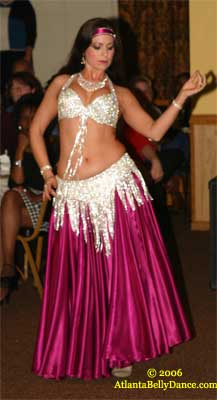
Skirt, Belt, and Bra |
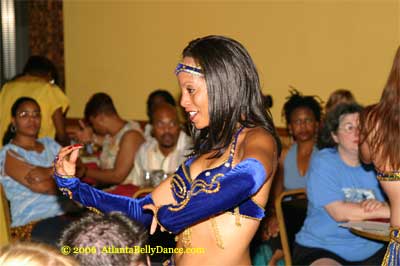
Headband, Armband or Sleeves |
Salome (www.orientaldancer. net/belly-dance-costumes.shtml) created an excellent overview for cabaret costumes, which will be summarized below.
There are a few main characteristics that can be used to classify costumes:
Main Characteristics of Costumes
| Style | Uniqueness | Quality |
|---|
- Turkish Style
- Egyptian Style
- American Fantasy Style
|
- Mass produced Costumes
- Designer Costumes (one of a kind, customized)
|
|
Foreword
| Turkish | Egyptian |
|---|
| The Turkish Belly dance costume consists of bra, belt and skirt. Also prevalent among current designs are hip accentuations built directly onto the skirt in lieu of a separate belt. Accessories can include headband, necklace, wrist or arm cuffs or unattached sleeves (either form fitting or flowing), and veil. Gowns are not common. Neither are pants, Turkish dancers often show legs to full advantage. Shoes are a possibility.
See also Turkish Style Dance
|
The typical Egyptian Belly dance costume is a gown or a bra and skirt with hip accentuations built directly onto it. Accessories can include a headband, arm cuffs or form fitting (unattached) sleeves, and a veil. In Egypt Oriental dancers are prohibited from exposing bare midriff. A body stocking, made from mesh with a loose or tight weave (colored or nude) is worn with two piece sets in obedience to this law. Shoes are a possibility.
See also Egyptian Style Dance
|
Mass Produced Belly Dance Costumes
| Turkish | Egyptian |
|---|
| Commonalities among mass produced Turkish Belly dance costumes are: 6 to 18 inch beaded fringe attached half way up the bra cup, with a center piece draping between the cups. Alternatively, the fringe may be attached at the base of the bra and extend around the back or only across the front. In either scenario the fringe on the belt attaches at the base.
The surface of the belt and bra are stitched in one color of sequin with a contrasting color used to create a design on each cup and in the center (front and back) of the belt. This is often a flowing abstract design, though sometimes recognizable patterns such as clam shells, diamonds, flowers etc. are used.
The edges of the bra and belt are often crafted in scallops, points, or curlicues etc. The belt (front and back) is cut in a sharp V shape. The V can be dainty or quite large.
A full costume will come with either a sheer pantaloon or skirt with no, or minimal, decoration and may also include a veil. Fabrics tend to be an industrial strength polyester/chiffon blend.
Higher end mass produced Turkish belly dance costumes share similar characteristics as lower end sets but are of superior quality. For example, the design patterns on the bra and belt will be in equal proportion and perfectly centered. Fringe will be the exact same length, and strung to last. Stitch work is sturdier. There will be more detail work on the skirt and veil. The shape, form and fit of the bra and belt are better. |
Lower end mass produced Egyptian Belly dance costumes are easy to spot. The fringe is 6 to 12 inches long with each strand ending in a plastic bead or palette. Fringe on the bra is attached in two places: across the base and in a large V starting at the outside of the cups and coming to a point where the cups adjoin. Though, a bra may come with only one arrangement of fringe. The fringe on the belt attaches at the base, often with an accenting piece attached to the center (front and back) of the belt.
The surface of the belt and bra is stitched in one solid color of sequins and host to no other decoration.
There is nothing notable about the shape of the current bra used in Egyptian Belly dance costumes. But the styling of the belt (low or high end) is distinct. The front part of the belt is rectangular in shape while the back is in a half circle, covering and slightly cupping the buttocks. The belt is often in one piece (unlike most Turkish belts that come in two parts) and the edges are clean and straight.
To interject opinion, these mass produced belts fit most women horribly! They are not darted to hug a womans curving figure so the bottom fits snugly while the top gaps unattractively.
A full costume includes bra, belt, skirt and matching rectangular or half circle veil. Fabrics tend to be a polyester/chiffon blend edged in seed beads and palettes. The skirt is either; a two or three paneled circle skirt decorated in sequined flowers. Or a pleated circle skirt with vertical rows of sequins. |
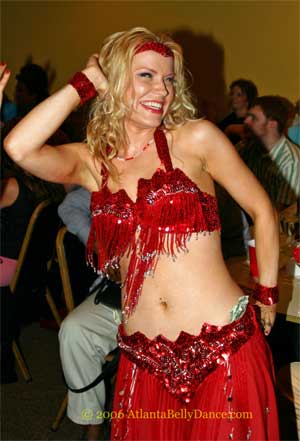
Beginner Turkish Costume |
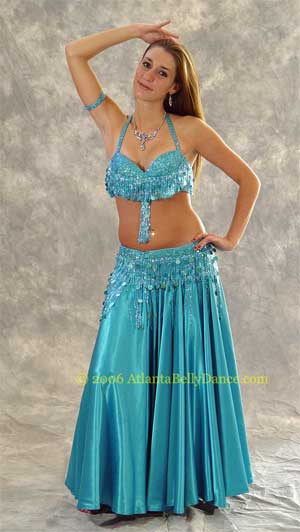
Beginner Egyptian Costume |
Unique - Designer - Custom Costumes
| Turkish | Egyptian |
| Commonalities among Turkish designer Belly dance costumes are harder to nail down because the nature of designing is the individual creativity of a designer. But some commentary can be made.
Beaded fringe remains in vogue, both long and short strands. Trends lean toward a fuller fringe on the belt with minimal, accenting fringe on the bra. Attaching fringe along the base of the belt is favored. If a skirt with no separate hip belt, ample fringe is attached (unlike its Egyptian counterpart).
Designer sets tend to use large and small glass stones heavily in combination with fabric, sequins, and seed beads to cover and decorate the surface of the bra, belt, and accent the accessories. Alternatively, the surfaces may be intricately stitched in dainty glass beads of contrasting colors. There is the tendency in both instances to decorate in flowing abstract patterns. Skirt and accessories are often heavily decorated, mimicking the work on the bra and belt.
Bra shapes vary from the classic bra to adjoining half vest, asymmetrical half top/half bra, large diamond shapes on the bottom of bra... Belt shapes are also varied though the V shape is trademark (designer sets tend to be daintier than mass produced counterparts).
Full designer costumes include decorative headband and necklace, some type of arm adornment as described in the foreword, a veil, bra, belt, and skirt. Fabrics used are velvet, crushed velvet, stretch velvet, chiffons and some lycra - mostly matte. |
These costumes do not share similar characteristics with lower end sets. Soft flowing looks, long, ample fringe and bra/belt/skirt sets are in the minority.
Gowns and bra with sleek skirt is where it's at. If there is fringe on the costume; chunky beads are used, often grouping several strands together and placing them sparingly on the pelvic area. Gowns and bra/skirts are made of like fabric (variants of lycra rule). Gowns often have mesh covered cut outs on the mid-section.
The bra cups, pelvic area and length of the skirt are embroidered in recognizable designs, such as flowers or flowing abstracts. Materials used are sequins and a variety of beads. Stones, large stones especially, are uncommon. Though there is a predilection for emphasizing the nipple area with a large stone. Decoration can be sparse or incredibly opulent! Because of the polyurethane fabrics the fit is snug and sleek. This goes for the accessaries too.
A full costume is gown plus head band, sleeves and veil or bra/skirt, headband, sleeves, and veil.
|
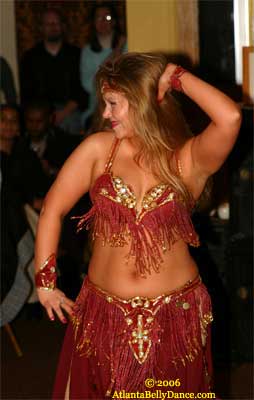
Designer Turkish Costume |

Designer Egyptian Costume |
(Source: Salome (www.orientaldancer. net/belly-dance-costumes.shtml))
Egyptian vs Turkish Costumes
I like the following article because it discusses more the fit, fragility/durability, and ease of modification of the costumes. (Source: bellydanceny. com/travel_costumes.html)
Egyptian costumes are the ultimate in glitz and glitter and retro glamour--Las Vegas, Liberace, the Old Elvis and Rita Hayworth all in one. They are showy as all get-out. and everything great about them can be seen from quite a distance. They are very visible from a stage and enhance and display all a dancer's movements quite wonderfully.. And Egyptian costumes are constructed like Egyptian monuments: they are built for the ages. Both the bras and the belts are made of heavily stiffened heavyweight buckram covered with fabric which in turn is covered with sequins, beads, stones, sequined and beaded and sometimes fringed appliques and finally, beaded fringe. Egyptian costumes stand up under pressure, perspiration, and hard use. They even stand up by themselves.The same can be said of gowns, skirts, veils and any other professional-grade accessories from Egypt.
Along with all this extreme glitz and sturdiness in Egyptian costumes comes difficulty in altering them and a rather high discomfort rating. They weigh a lot, don't give or bend with the body and tend to scratch their wearers.
Getting a good fit in ready-to-wear Egyptian costumes can be a problem. The basic bra cup is available in only a few styles and three sizes. Either it fits or forget it. And the story is pretty much the same for Egyptian belts. They are usually constructed in one piece with a side fastening. If the ornamentation is in a symetrcial pattern the belt needs to be cut up and reconstructed to alter it.
However, once you have gone all the way to Egypt you don't have to rely on ready-to-wear. If you know a little bit about getting around and where to go you can have a custom-made costume or tailored alterations done just for you.
If we think of Egyptian costumes as Earth, then Turkish costumes are Air: light, shimmering, changeable, supple. Construction is minimal. Both bras and belts are often made with wired frames under soft fabric. This allows the costumers to make interesting shapes along the edges of both bra and belt. Sculptural effects are also featured in the sequin and bead work on the body of the costumes. Three dimensional designs are achieved by sewing rows of sequins with bead spacers in floral or butterfly or star patterns. Intricate overlays of sequins are used to achieve subtle iridescence. Delicate fringes in different lengths and bead colors and sizes complete these confections. If Bottecelli's Venus had been a bellydancer she would have come out of the sea wearing a Turkish costume.
And compared with the Egyptian product, Turkish costumes are comfortable to wear and easy to alter. Also, Turkish costumes often come with sets of sweet little sequined accessories such as hand pieces, necklets, headbands and even foot coverings.
However all this loveliness is plagued by one very big problem. These costumes are fragile as butterflies and as ephermeral as clouds. Even given that most of the Turkish costume makers have ceased using thin, easily broken thread, if you dance hard or often you may be doing constant maintainence. Also, be warned: the skirts and veils that come with most Turkish costumes are often worse than useless--skimpy, uninteresting, overly revealing, etc.You will probably have to spend some more money when you get home for something real to go with your Turkish bra, belt and accessories.
For a Turkish costume to achieve its full impact the dancer needs to be very close to the audience. The subtle effects of sculpted beadwork and overlays get lost across a room. In fact, these costumes are often most impressive just lying on a table or hanging on a wall like the works of art they are.
Beledi Dress
Beledi (BELL uh dee) means "my country", "my village" or "my home town" in Arabic.
There is a distinct beledi rythm, and a distinct Beledi Dress.
The Beledi Dress is a long, floor-length dress. Made of natural fiber such as cotton, it gives a very folkloric look. Made out of a sheer or glittery fabric, it offers a nice covered option for a cabaret performance. In Egyptian nightclubs, after performing a raqs sharqi routine in bedleh, the dancer usually goes backstage and changes costumes, then comes out wearing a beledi dress to do a folkloric dance.
Beledi dances often use similar moves to that of the Ghawazee.
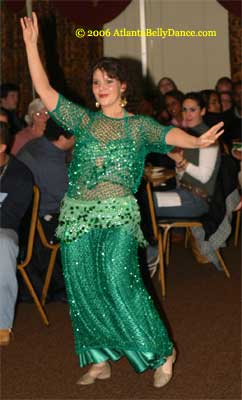 |
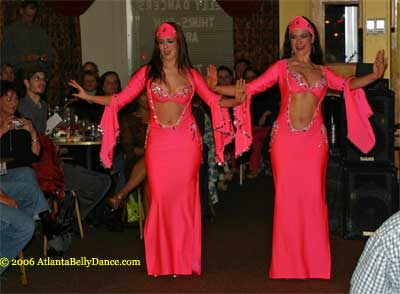
"Urban Beledi" w/ glitzier costumes & mixes cabaret & folk styles. |
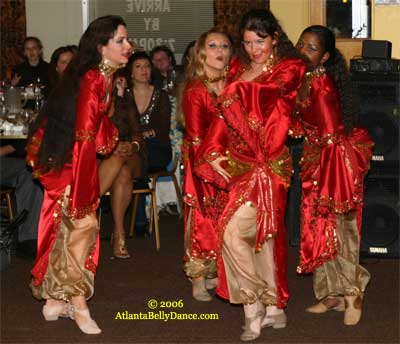
Very popular for group/troupe dances, as one size fits most |
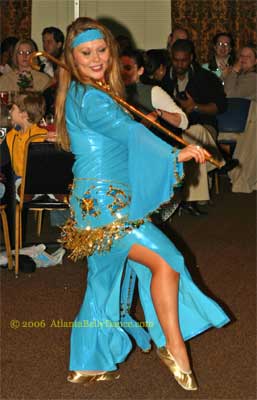
Raks Assaya (Cane dance) in Beledi dress |
Choli
Choli (CHOH lee) – bare-midriff, fitted blouse worn under saris by women in India.
A close fit is the main characteristic of the choli, since it serves both as an undergarment and a blouse for the sari.
The specific styling of the choli can vary from one region of India to another. Of course, the choli is used for Bollywood style dancing.
|
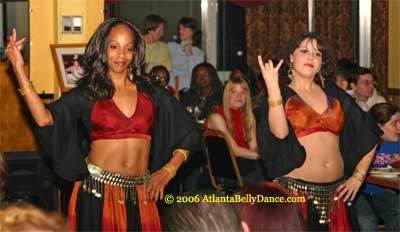
|
Khaleegy Dress - Thobe Al Nasha'ar - Saudi
The typical costuming for the saudi-style Khaleegy dance would be a thobe al nasha'ar worn to cover up your party clothes underneath. The term Khaleegy Dress, which appears in some belly dance catalogs that sell them, is another name for a Thobe Al Nasha'ar.
Thobe Al Nasha'ar. (Pronounced "tobe ahl nahsha ar".) You may also see this spelled Taub. This is a richly embroidered dress worn in the Persian Gulf (Khaleegy) region, in countries like Saudi Arabia, Kuwait, and Dubai.
See weekly.ahram.org. eg/2002/603/li2.htm
|
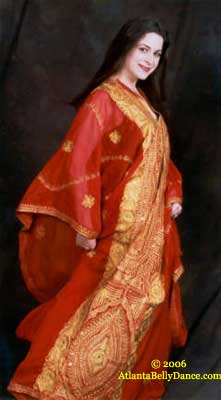
|
American Fantasy
Well, here everything goes. Many costumes are based on the turkish/egyptian styles, but variations include material used, combinations of styles, or borrowing ideas from related dance styles. Some samples are shown:
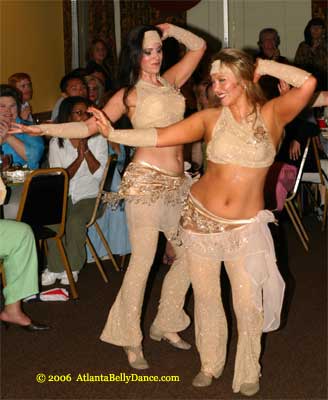 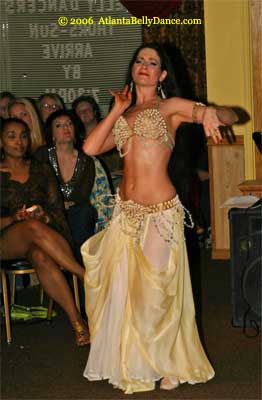
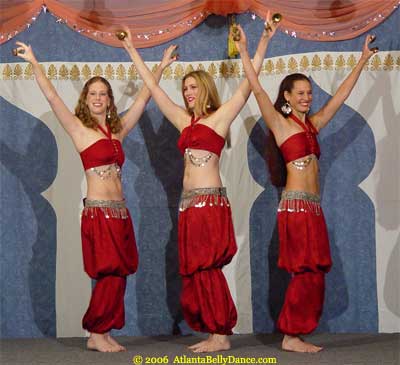
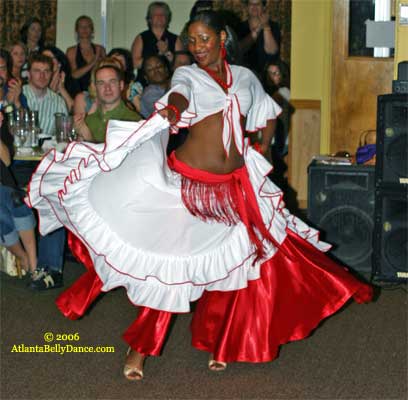
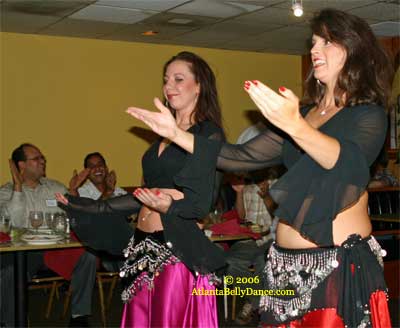
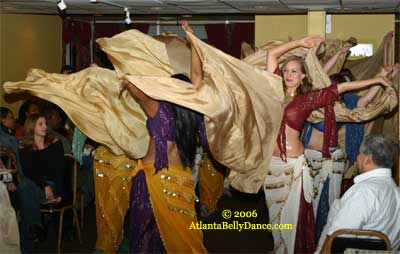
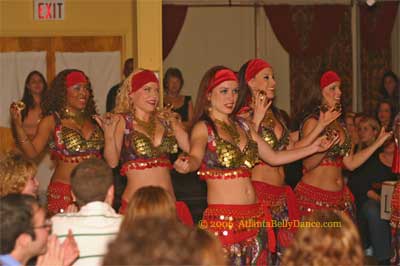
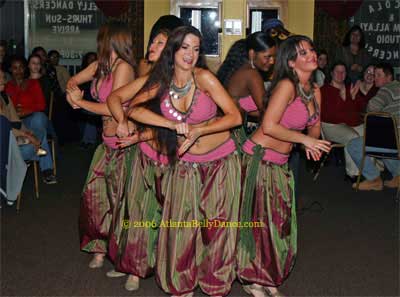
American Tribal
The "founder" of tribal style, Jamila Salimour, and her dance troupe, Bal-Anat, use distinctive costuming with black and silver asuit, and facial drawings to simulate tribal tatoos. A later offshoot of the American Tribal troupe, spearheaded by Carolena Nericcio is called “Fat Chance Belly Dance”. It has a distinctive and colorful, costumed character of its own by use of choli tops from India, tightly wrapped turbans, Afghan jewelry and camel tassels.
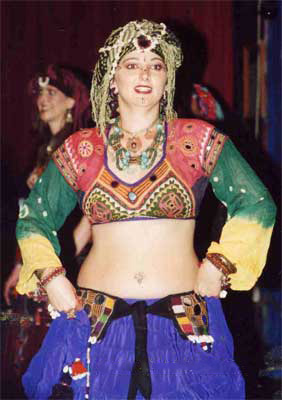 |
Many different Tassels are used, i.e. Tassels for hip sash tassle belts, silk and beaded tassels from the Turkoman & Baluch tribes, wool & cowry shells for headdresses, hair falls & turban adornment. Tribal tassels have been lovingly used for years, decorating the yurts, caravans & costumes of our tribal sisters, their children, animals, horses & camels.
(Source: www.tribalmax. com/tassels/tassels.html)
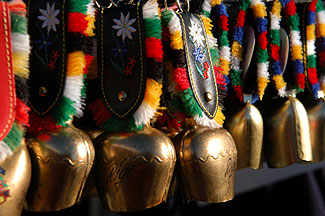
(Left: Nicolae from Awalim, Atlanta)
|
Gallabiya
The Gallabiya (Pronounced "gal uh BEE yuh") refers to a simple-cut full-length dress or robe. The term also refers to the full-length cotton robes that many men in Egypt still wear for everyday life today instead of shirts with pants.
While not per-se used for dancing, it is used by belly dancers to cover themselves up before or after a performance. Professional dancers want to maintain the illusion of the "exotic" and "mysterious" dancer, and clearly distinguish the time when they are "on stage" in costume from their downtime, when they would talk to friends/customers or drink some water.
Other spellings are - in case you were wondering, gallabia, gallabiah, gallabieh, gallabiya, gallabiyah, gallabiyeh, galabea, galabeah, galabia, galabiah, galabieh, galabiya, galabiyah, galabiyeh
(source plex. us/archives/word.html)
| 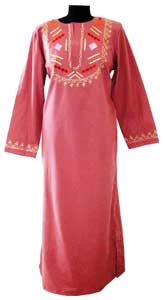 |
Sources:
www.orientaldancer. net/belly-dance-costumes.shtml
www.neareastdance. com/BellydanceFAQs.html
www.shira. net/glossary.htm
www.danceir. com/Belly%20Dance%20History.htm
weekly.ahram.org. eg/2002/603/li2.htm
www.tribalmax. com/tassels/tassels.html
|
|
|
























